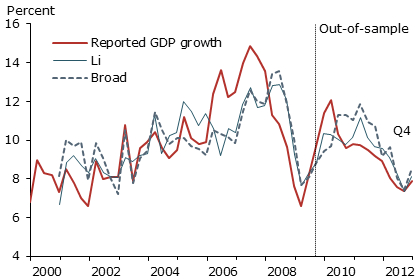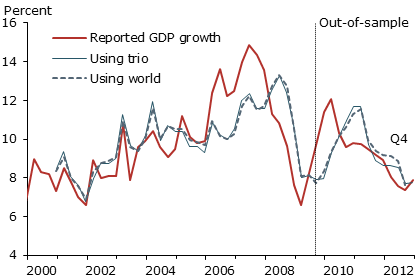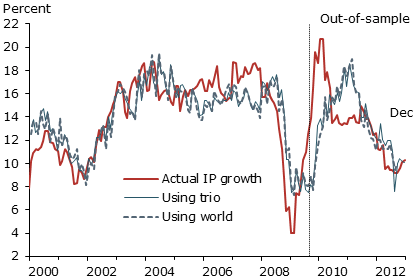Some commentators have questioned whether China’s economy slowed more in 2012 than official gross domestic product figures indicate. However, the 2012 reported output and industrial production figures are consistent both with alternative Chinese indicators of the country’s economic activity, such as electricity production, and trade volume measures reported by non-Chinese sources. These alternative domestic and foreign sources provide no evidence that China’s economic growth was slower than official data indicate.
China has been a bright spot in a global economy that is still recovering from the financial crisis that started in 2007. In 2012, China’s officially reported gross domestic product (GDP) growth slowed modestly to a bit under 8% from about 9¼% in 2010 and 2011. For virtually any country other than China, such a growth rate would be considered exceptional. However, some press reports were skeptical that the slowdown was as mild as official data indicated (for example, see Bradsher 2012).
This Economic Letter explores whether the recent pattern in China’s official GDP data is consistent with a range of alternative indicators of Chinese economic activity. Some of these indicators are produced by agencies of the Chinese government. We also examine trading-partner data on exports to and imports from China produced by non-Chinese sources. Historically, both these domestic and foreign indicators have closely tracked official Chinese output statistics. In 2012, they were broadly consistent with China’s reported slowdown in growth of industrial production and GDP. Moreover, these data are consistent with the pickup in growth observed in the fourth quarter of 2012 from earlier in the year. Hence, we find no evidence that China’s slowdown in 2012 was greater than officially reported.
Evidence from domestic Chinese data
Since the 1990s, a number of commentators have expressed concern about the accuracy of Chinese statistics. The challenges of producing accurate statistics are substantial in an economy growing as fast as China’s, in which the structures of production and expenditure are changing rapidly (see Holz 2008). Furthermore, even prominent Chinese political leaders have expressed concern that certain key statistics might sometimes be manipulated for political advantage. For example, in remarks to the U.S. ambassador in 2007, Vice Premier Li Keqiang stated, “GDP figures are ‘man-made’ and therefore unreliable,” according to a Wikileaks release of a U.S. diplomatic cable (see Wikileaks 2007).
Figure 1
Recent GDP figures consistent with other indicators

China’s GDP data move closely in sync with other high-profile official indicators, such as industrial production and retail sales. However, these indicators might themselves be distorted. In addition, to the extent these indicators are incorporated directly into GDP as inputs, they might not vary independently.
To test the accuracy of Chinese GDP data, we compared them with a range of alternative domestic indicators available over a long time span that seem less subject to manipulation. We grouped these alternative indicators into two sets. The first set, labeled “Li” in Figure 1, was based on the preferences of Vice Premier Li, as reported in the 2007 U.S. diplomatic cable. He said he got a better read on the pace of economic activity by looking at electricity production, rail cargo shipments, and loan disbursements. In his view, those data were relatively accurate. The second set of alternative indicators, labeled “Broad” in Figure 1, included an index of consumer sentiment, construction of new floor space, an index of raw materials usage, air passenger volume, and the nominal value of new residential real estate construction.
We then examined year-over-year values for GDP and our two sets of alternative indicators. For each of the sets, we performed a statistical exercise known as principal components. This method synthesized the fluctuations in these indicators into two indexes, one for each of the two sets. Creating summary indexes rather than using the eight indicators individually simplified the analysis.
Next, we looked at the statistical relationship between the two alternative indicator indexes and China’s GDP over a sample period from the first quarter of 2000 through the third quarter of 2009. We then used the information on the statistical relationship between GDP and the indexes during this period to project GDP growth from the fourth quarter of 2009 through 2012. This allowed us to check whether recent data are consistent with the relationship observed from 2000 through 2009. For details concerning our techniques, see our technical appendix at https://www.frbsf.org/publications/economics/letter/2013/el2013-08-technical-appendix.pdf. Data used in the study are available at https://www.frbsf.org/publications/economics/letter/2013/el2013-08-data-appendix.xlsx.
Figure 1 plots the relationship between reported GDP growth and our two alternative indicator indexes. It includes the statistical predictions made for 2009 through 2012, outside the sample period. We do not expect a precise match between our projections and GDP as actually reported because the predictions are based on an approximate statistical model subject to various sources of error.
For the third quarter of 2012, this method predicts values for year-over-year GDP growth that represent a slightly larger slowdown than China officially reported. By contrast, for the fourth quarter of 2012, both alternative indicator indexes turned less negative and the predicted values exceed officially reported GDP. The recent misses are not large in statistical terms.
Our statistical method tells whether recent data are consistent with the relationship observed in the past. We conclude that the typical relationship between the alternative indicators and GDP observed from 2000 to 2009 continued to hold through 2012. In other words, the 2012 slowdown in reported growth—and its modest rebound in the fourth quarter—do not deviate from previously reported patterns. However, our results don’t provide evidence on the overall, long-term accuracy of Chinese GDP statistics. For example, if Chinese GDP had been consistently overreported over time, then our measured statistical relationships would be skewed by this persistent bias.
Consistency with data reported outside China
While neither of our alternative indicator indexes seems likely to have been substantially manipulated, all the components were produced by Chinese authorities. As such, our exercises may only partially address concerns about the accuracy of Chinese data. Therefore, we also compare official Chinese GDP figures with external indicators of Chinese economic activity.
Specifically, we look at Chinese imports and exports reported by its trading partners. Exports to China are likely to be positively correlated with Chinese aggregate demand. Moreover, to the extent that these exports are intermediate inputs for Chinese manufacturing, they would also be positively correlated with industrial production. In turn, imports of Chinese products generally reflect external demand for Chinese goods and services.
We used two sources of trading-partner data. The first is based on trade with the United States, the European Union, and Japan, a group we call the “trio.” These three trading partners account for about half of global imports from China and about a third of exports to China. Trade data from these partners are available with a relatively short lag.
The second trade-data source is based on China’s overall global imports and exports. The International Monetary Fund collects these data from individual countries, but they are available with a longer lag than data from the trio. In all cases, we include Hong Kong in our measures because it serves as an intermediary for Chinese trade. It is often hard to differentiate between trade with Hong Kong and with the rest of China for statistical purposes.
Figure 2
Chinese GDP consistent with trading-partner data

We transformed the data in three ways. First, the trade figures are in U.S. dollars, so we adjusted exports and imports for inflation by using U.S. price data for all countries. For exports, we constructed a price index from commodity-specific export price indexes weighted by the nominal commodity shares of U.S. exports to China. For imports, we made an inflation adjustment that included all products except petroleum. Statistical results were similar when we used nominal, unadjusted trade values. Second, we used year-over-year growth rates. Third, for the trio on the one hand and the world data on the other hand, we combined export and import growth into two indexes using the principal components method, as we did with the Chinese indicators. Because exports and imports are highly correlated, results turned out to be qualitatively similar whether we used exports and imports individually or combined.
Figure 3
Chinese industrial production also consistent

We found that, in statistical terms, trading-partner data are significantly and positively correlated with Chinese GDP and industrial production. Figure 2 shows the predictions for GDP growth based on trio and overall world exports to China. As in Figure 1, we estimated the relationships based on data through the third quarter of 2009 and predicted GDP for the fourth quarter of 2009 through 2012. The errors are sometimes large. Nonetheless, the slowdown in China’s GDP from 2011 to 2012 is roughly consistent with the values predicted by the trading-partner data.
Figure 3 shows the same exercise using monthly industrial production data. Not surprisingly, the link with trade statistics is even closer because both involve tangible goods. The model does a good job at capturing the 2008 downturn and 2009 resurgence in industrial production. In 2010, China’s industrial production growth was lower than predicted. But the match in 2011 and 2012 is reasonably tight. Hence, the recent Chinese industrial production data also appear to be consistent with Chinese trade volumes as reported by trading partners. The fit is even closer when only China’s imports are used in the exercise.
Conclusion
We found that reported Chinese output data are systematically related to alternative indicators of Chinese economic activity. These include alternative indicator indexes of Chinese activity composed of variables that are less susceptible to official manipulation, as well as externally reported trade volume measures. Importantly, these models suggest that Chinese growth has been in the ballpark of what official data have reported. We find no evidence that recently reported Chinese GDP figures are less reliable than usual.
References
Bradsher, Keith. 2012. "China Data Mask Depth of Slowdown, Executives Say.” New York Times, June 22.
Holz, Carsten A. 2008. "China’s 2004 Economic Census and 2006 Benchmark Revision of GDP Statistics: More
Questions than Answers?" The China Quarterly, March.
Wikileaks. 2007. “Fifth Generation Star Li Keqiang Discusses Domestic Challenges, Trade Relations with
Ambassador.” Cable, March 15. http://wikileaks.org/cable/2007/03/07BEIJING1760.html
Opinions expressed in FRBSF Economic Letter do not necessarily reflect the views of the management of the Federal Reserve Bank of San Francisco or of the Board of Governors of the Federal Reserve System. This publication is edited by Anita Todd and Karen Barnes. Permission to reprint portions of articles or whole articles must be obtained in writing. Please send editorial comments and requests for reprint permission to research.library@sf.frb.org